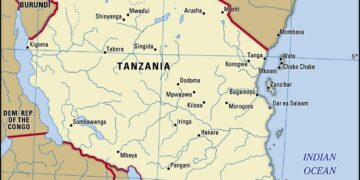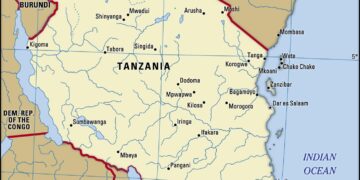Dar es Salaam Port Closure Disrupts East African Exports Amid Growing Economic Concerns
The closure of Dar es Salaam port, a vital artery for trade in East Africa, has sparked alarm among exporters and businesses in the region, as crucial supply chains face significant disruptions. The port, which serves as the principal gateway for goods entering and leaving Tanzania, has been rendered inoperative due to ongoing maintenance and operational challenges, impacting not only Tanzania’s economy but also that of its neighboring nations reliant on its shipping routes. As the consequences of the closure begin to unfold, stakeholders are raising urgent concerns about the potential long-term effects on trade, inflation, and regional economic stability. This article delves into the implications of the port’s shutdown, the responses from local authorities, and the broader fallout for East African exports.
Dar es Salaam Port Shutdown Disrupts East African Trade Routes
The prolonged closure of Dar es Salaam Port is creating significant disruptions in trade across East Africa, severely impacting regional supply chains and economies. As one of the key maritime gateways for landlocked countries such as Rwanda, Burundi, and the Democratic Republic of the Congo, the stagnation of operations at the port has led to an escalation in shipping costs and delays in exports. Importers are struggling to manage inventory and meet demand, while businesses that rely on timely shipments face potential financial losses.
Many industry leaders are voicing concerns over the situation, which is compounded by rising freight rates and limited access to alternative shipping routes. Key sectors affected include:
- Agriculture: Delayed exports of crops like coffee, tea, and horticulture products.
- Mining: Disruption in the shipment of minerals such as gold and copper.
- Manufacturing: Shortages of raw materials impacting production schedules.
In response, experts suggest that regional governments must collaborate to expedite the reopening of the port and explore alternative logistics options. Enhanced investment in transport infrastructure and streamlined customs processes could mitigate the long-term effects of this disruption on East African trade.
Economic Fallout: Impact of Port Closure on Regional Exports
The closure of the Dar es Salaam port has sent shockwaves through the East African export sector, exacerbating existing supply chain challenges and affecting a wide range of commodities. The port, a crucial gateway for landlocked neighbors such as Zambia, Uganda, and Rwanda, handles a significant portion of the region’s trade. With shipping schedules disrupted and goods piling up, exporters face increased costs and delays, directly impacting their competitiveness in global markets. Stakeholders are now grappling with both the immediate financial implications and the long-term repercussions of this unprecedented disruption.
Industry experts have highlighted several key areas of concern stemming from the port’s closure:
- Lost Revenue: Exporters are suffering from substantial losses due to halted shipments and buyer cancellations.
- Job Cuts: Many companies may be forced to downsize or freeze hiring as they navigate through this turbulent period.
- Inflationary Pressures: The scarcity of essential goods could lead to price hikes, exacerbating economic challenges for consumers across the region.
To illustrate the critical nature of the port’s role in regional trade, the following table outlines the typical volume of goods handled by Dar es Salaam and their destinations before the closure:
| Commodity | Volume (in tons) | Key Destinations |
|---|---|---|
| Coffee | 100,000 | Germany, USA |
| Tea | 75,000 | UK, Middle East |
| Minerals | 200,000 | China, South Africa |
The urgency for alternative logistical solutions is palpable, as regional governments and businesses seek to mitigate the fallout of this crisis. Long-term investments in infrastructure and diversified transport strategies will be critical to prevent similar setbacks in the future and ensure the resilience of East Africa’s export economy.
Recommended Strategies for Mitigating Supply Chain Disruptions in East Africa
In response to the recent closure of the Dar es Salaam port, businesses and policymakers must adopt adaptive strategies to enhance resilience against supply chain disruptions. Diversifying logistics networks is essential, as relying solely on one port exposes exporters to significant risks. Stakeholders can explore alternative routes through regional ports such as Mombasa and Beira, thereby reducing dependency on a single transit point. Investing in robust regional partnerships and collaborations can also streamline operations and ensure that an array of transport options are readily available during crises. By leveraging local transport service providers, businesses can mitigate delays and uphold the flow of goods to their markets.
Strengthening digital supply chain management tools can play a pivotal role in enhancing visibility and responsiveness to disruptions. Implementing advanced technologies like blockchain and IoT can empower stakeholders with real-time data, assisting in proactive decision-making and effective resource allocation. Additionally, fostering supplier relationships and establishing local sourcing networks can bolster the supply chain’s overall robustness. By prioritizing local suppliers, businesses not only reduce transportation risks but also stimulate local economies, creating a more interconnected and resilient East African market.
In Conclusion
In conclusion, the prolonged closure of the Dar es Salaam port poses a significant threat to the economic stability of East Africa, with ripple effects likely to be felt across various sectors reliant on timely exports. As stakeholders grapple with the implications of this disruption, the urgent need for both immediate solutions and long-term infrastructural improvements becomes increasingly clear. The resilience of East African trade hinges on the swift resolution of this crisis, underscoring the vital importance of maintaining open trade routes for the region’s economic growth and development. As the situation evolves, ongoing monitoring and strategic planning will be essential to mitigate further damage and restore the port to its critical role in facilitating regional commerce.














